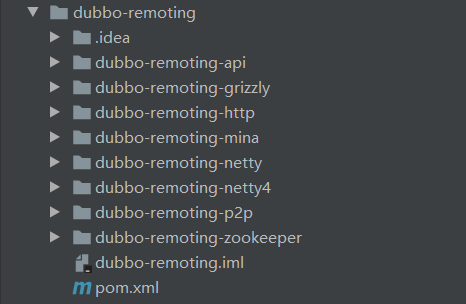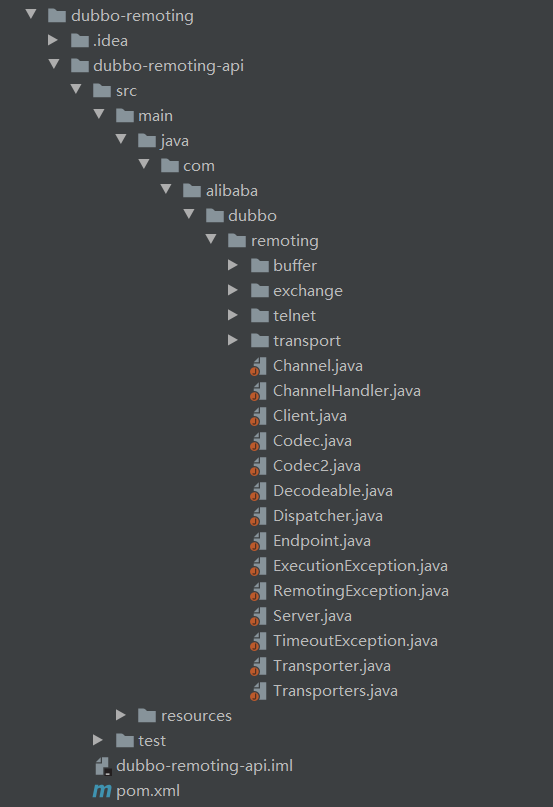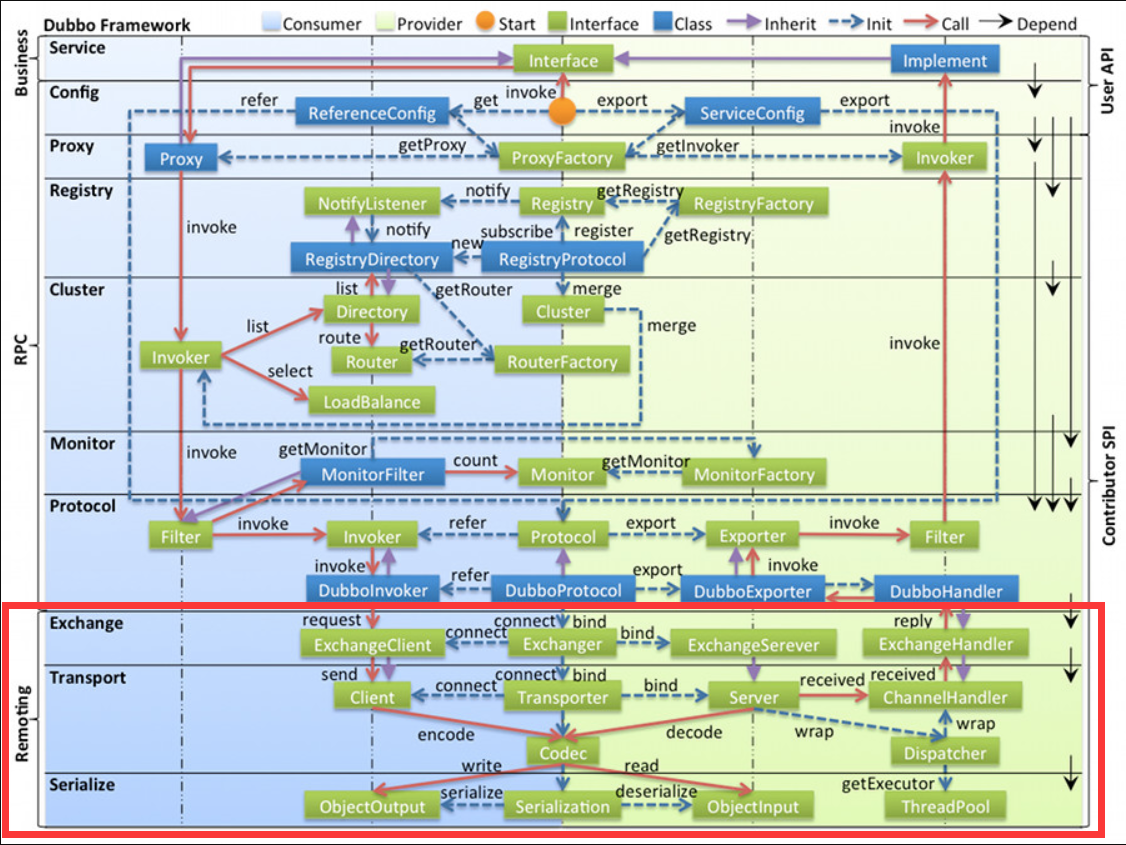dubbo-remoting 模块整体结构设计
服务治理框架 大致可分为 “服务通信” 和 “服务管理” 两部分,前面我们分析了有关注册中心的源码,也就是服务管理,接下来要分析的就是跟服务通信有关的源码,也就是远程通讯模块。该模块中提供了多种客户端和服务端通信的功能,而在对 NIO 框架选型上,dubbo 交由用户选择,它集成了 mina、netty、grizzly 等各类 NIO 框架来搭建 NIO 服务器和客户端,并且利用 dubbo 的 SPI 扩展机制可以让用户自定义选择。dubbo-remoting 的工程结构如下。

dubbo-remoting-api 模块整体结构设计
本篇我们先来看一下 dubbo-remoting 中 dubbo-remoting-api 的项目结构。

dubbo-remoting-api 定义了远程通信模块最核心的 API,对于 dubbo-remoting-api 的解读会分为如下五个部分,其中第五部分会在本文介绍。
- buffer 包:缓冲在 NIO 框架 中是很重要的存在,各个 NIO 框架 都实现了自己相应的缓存操作。这个 buffer 包 下包括了缓冲区的接口以及抽象类;
- exchange 包:信息交换层,其中封装了请求响应模式,在传输层之上重新封装了 Request-Response 语义,为了满足 RPC 的需求。这层可以认为专注在 Request 和 Response 携带的信息上。该层是 RPC 调用 的通讯基础之一;
- telnet 包:dubbo 支持通过 telnet 命令 来进行服务治理,该包下就封装了这些通用指令的逻辑实现;
- transport 包:网络传输层,它只负责单向消息传输,是对 Mina、Netty、Grizzly 的抽象,它也可以扩展 UDP 传输,该层也是 RPC 调用 的通讯基础之一;
- 最外层的源码:该部分也是我们接下来要重点解析的。
结合 dubbo-remoting-api 模块 的外层类和包划分,我们看看下面的官方架构图。

红框标注的部分是 dubbo 整体架构中的 远程通讯架构,其中 Exchange 组件 和 Transport 组件 在框架设计中起到了很重要的作用,也是支撑 Remoting 的核心。
dubbo-remoting-api 模块最外层源码解析
Endpoint 接口
dubbo 抽象出了一个端的概念,也就是 Endpoint 接口,这个端就是一个点,而点与点之间可以双向传输。在端的基础上再衍生出通道、客户端以及服务端的概念,也就是下面要介绍的 Channel、Client、Server 三个接口。在传输层,Client 和 Server 的区别只是语义上的区别,并不区分请求和应答职责,而在交换层,Client 和 Server 是有方向的端点,所以区分了明确的请求和应答职责。两者都具备发送的能力,只是客户端和服务端所关注的事情不一样,而 Endpoint 接口抽象的方法就是它们共同拥有的方法。这也就是它们都能被抽象成端的原因。
1
2
3
4
5
6
7
8
9
10
11
12
13
14
15
16
17
18
19
20
21
22
23
24
25
26
27
28
29
30
31
32
33
34
35
36
37
38
39
40
41
42
43
44
45
46
47
48
49
50
51
52
53
54
55
56
57
58
59
60
61
62
63
64
65
|
/**
* Endpoint. (API/SPI, Prototype, ThreadSafe)
*
* Endpoint 接口
*/
public interface Endpoint {
/**
* get url.
*
* @return url
*/
URL getUrl();
/**
* get channel handler.
*
* 获得通道处理器
*
* @return channel handler
*/
ChannelHandler getChannelHandler();
/**
* get local address.
*
* @return local address.
*/
InetSocketAddress getLocalAddress();
/**
* send message.
*
* @param message 消息
* @throws RemotingException
*/
void send(Object message) throws RemotingException;
/**
* send message.
*
* @param message 消息
* @param sent already sent to socket?
*/
void send(Object message, boolean sent) throws RemotingException;
/**
* close the channel.
*/
void close();
/**
* Graceful close the channel.
*/
void close(int timeout);
void startClose();
/**
* is closed.
*
* @return closed
*/
boolean isClosed();
}
|
Channel 接口
该接口是通道接口,通道是信息传输的载体。Channel 可读可写,并且可以异步读写。Channel 是 client 和 server 的数据传输桥梁。Channel 和 client 是一对一的,也就是一个 client 对应一个 Channel,而 Channel 和 server 则是多对一,也就是一个 server 可以对应多个 Channel。
1
2
3
4
5
6
7
8
9
10
11
12
13
14
15
16
17
18
19
20
21
22
23
24
25
26
|
/**
* Channel. (API/SPI, Prototype, ThreadSafe)
*
* 通道接口
* 可以看到 Channel 继承了 Endpoint,也就是端抽象出来的方法也同样是 channel 所需要的
*/
public interface Channel extends Endpoint {
/** 获得远程地址 */
InetSocketAddress getRemoteAddress();
/** 判断通道是否连接 */
boolean isConnected();
/** 判断是否有该key的值 */
boolean hasAttribute(String key);
/** 获得该key对应的值 */
Object getAttribute(String key);
/** 设置属性 */
void setAttribute(String key, Object value);
/** 删除属性 */
void removeAttribute(String key);
}
|
ChannelHandler 接口
1
2
3
4
5
6
7
8
9
10
11
12
13
14
15
16
17
18
19
20
21
22
23
24
25
|
/**
* ChannelHandler. (API, Prototype, ThreadSafe)
*
* 通道处理器接口
* 该接口负责Channel中的逻辑处理,可以看到这个接口有@SPI注解,是个可扩展接口
*/
@SPI
public interface ChannelHandler {
/** 连接该通道 */
void connected(Channel channel) throws RemotingException;
/** 断开该通道 */
void disconnected(Channel channel) throws RemotingException;
/** 发送给这个通道消息 */
void sent(Channel channel, Object message) throws RemotingException;
/** 从这个通道内接收消息 */
void received(Channel channel, Object message) throws RemotingException;
/** 从这个通道内捕获异常 */
void caught(Channel channel, Throwable exception) throws RemotingException;
}
|
Client 和 Resetable 接口
1
2
3
4
5
6
7
8
9
10
11
12
13
14
15
16
17
18
19
20
21
22
23
24
|
/**
* Remoting Client. (API/SPI, Prototype, ThreadSafe)
*
* 客户端接口,可以看到它继承了 Endpoint、Channel 和 Resetable接口,继承Endpoint的原因上面已经提到过了,
* 客户端和服务端其实只是语义上的不同,客户端就是一个点。继承 Channel 是因为客户端跟通道是一一对应的,
* 所以做了这样的设计,还继承了 Resetable接口 是为了实现 reset方法,该方法已经打上 @Deprecated注解,不推荐使用。
* 除了这些客户端就只需要关注一个重连的操作。
*/
public interface Client extends Endpoint, Channel, Resetable {
/** 重连 */
void reconnect() throws RemotingException;
/** 重置,不推荐使用 */
@Deprecated
void reset(com.alibaba.dubbo.common.Parameters parameters);
}
public interface Resetable {
// 用于根据新传入的 url 属性,重置自己内部的一些属性
void reset(URL url);
}
|
Server 接口
1
2
3
4
5
6
7
8
9
10
11
12
13
14
15
16
17
18
19
20
21
|
/**
* Remoting Server. (API/SPI, Prototype, ThreadSafe)
*
* 服务端接口,继承了 Endpoint 和 Resetable,继承 Endpoint 是因为服务端也是一个点,
* 继承 Resetable接口 是为了继承 reset方法。除了这些以外,服务端独有的是检测是否启动成功,
* 以及获得连接到 该服务端上的所有Channel,这里获得所有Channel其实就是获取所有连接该服务器的客户端
*/
public interface Server extends Endpoint, Resetable {
/** 是否绑定本地端口,提供服务。即,是否启动成功,可连接,接收消息等 */
boolean isBound();
/** 获得连接到 服务端的通道们(客户端) */
Collection<Channel> getChannels();
/** 通过远程地址获得该地址对应的通道 */
Channel getChannel(InetSocketAddress remoteAddress);
@Deprecated
void reset(com.alibaba.dubbo.common.Parameters parameters);
}
|
Codec2 接口
这两个都是编解码器 接口,在网络中进行传输的数据 都是原始的字节序列,这就需要 发送端使用编码器把 要传输的有意义的信息 序列化成字节序列,接收端再使用解码器 把字节序列再反序列化成 有效信息,而同时具备这两种功能的单一组件就叫 编解码器。在 dubbo 中 Codec 是老编解码器接口,而 Codec2 是新编解码器接口,并且 dubbo 已经用 CodecAdapter 把 Codec 适配成 Codec2 了。所以在这里就只介绍下 Codec2 接口。
1
2
3
4
5
6
7
8
9
10
11
12
13
14
15
16
17
18
19
20
21
22
23
24
25
26
|
/**
* 编解码器接口,需要注意的是:
* 1、Codec2 有 @SPI注解,是一个可扩展接口;
* 2、用到了 Adaptive机制,首先去 url 中找 key 为 codec 的 value,来加载 url 携带的配置中指定的 codec的实现;
* 3、该接口中有个枚举类型 DecodeResult,因为解码过程中,需要解决 TCP 拆包、粘包的场景,所以增加了这两种解码结果,
* 关于TCP 拆包、粘包的场景 可用看一下Netty源码解析中的内容
*/
@SPI
public interface Codec2 {
/** 编码 */
@Adaptive({Constants.CODEC_KEY})
void encode(Channel channel, ChannelBuffer buffer, Object message) throws IOException;
/** 解码 */
@Adaptive({Constants.CODEC_KEY})
Object decode(Channel channel, ChannelBuffer buffer) throws IOException;
/** 解码结果 */
enum DecodeResult {
/** 需要更多输入 */
NEED_MORE_INPUT,
/** 忽略一些输入 */
SKIP_SOME_INPUT
}
}
|
Decodeable 接口
1
2
3
4
5
6
7
8
9
10
|
/**
* 可解码的接口,该接口有两个作用,第一是在调用真正的 decode方法 实现的时候会有一些校验,
* 判断是否可以解码,并且对解码失败会有一些消息设置;第二个是被用来 message核对用的。
* 后面看具体的实现会更了解该接口的作用。
*/
public interface Decodeable {
/** 解码 */
void decode() throws Exception;
}
|
Dispatcher 接口
1
2
3
4
5
6
7
8
9
10
11
12
13
14
15
16
|
/**
* 调度器接口,不同的调度器实现,将操作转发到对应的线程池。
* 其中 dispatch 是线程池的调度方法,需要注意的是:
* 1、该接口是一个可扩展接口,并且默认实现AllDispatcher,也就是所有消息都派发到线程池,
* 包括请求,响应,连接事件,断开事件,心跳等;
* 2、用了 Adaptive注解,也就是按照 URL中的配置来加载实现类,后面两个参数是为了兼容老版本,
* 如果这是三个key对应的值都为空,就选择AllDispatcher来实现。
*/
@SPI(AllDispatcher.NAME)
public interface Dispatcher {
/** dispatch the message to threadpool. */
@Adaptive({Constants.DISPATCHER_KEY, "dispather", "channel.handler"})
// The last two parameters are reserved for compatibility with the old configuration
ChannelHandler dispatch(ChannelHandler handler, URL url);
}
|
Transporter 接口
1
2
3
4
5
6
7
8
9
10
11
12
13
14
15
16
17
18
19
20
21
22
23
24
|
/**
* 网络传输接口,需要注意的是:
* 1、该接口是一个可扩展接口,并且默认实现 NettyTransporter;
* 2、用了 dubbo SPI扩展机制中的Adaptive注解,加载对应的bind方法,使用url携带的server或者transporter属性值,
* 加载对应的connect方法,使用url携带的client或者transporter属性值
*/
@SPI("netty")
public interface Transporter {
/** 绑定一个服务器 */
@Adaptive({Constants.SERVER_KEY, Constants.TRANSPORTER_KEY})
Server bind(URL url, ChannelHandler handler) throws RemotingException;
/**
* 连接一个服务器,即创建一个客户端
*
* @param url server url 服务器地址
* @param handler 通道处理器
* @return client 客户端
* @throws RemotingException 当连接发生异常时
*/
@Adaptive({Constants.CLIENT_KEY, Constants.TRANSPORTER_KEY})
Client connect(URL url, ChannelHandler handler) throws RemotingException;
}
|
Transporters 类
1
2
3
4
5
6
7
8
9
10
11
12
13
14
15
16
17
18
19
20
21
22
23
24
25
26
27
28
29
30
31
32
33
34
35
36
37
38
39
40
41
42
43
44
45
46
47
48
49
50
51
52
53
54
55
56
57
58
59
60
61
62
63
64
65
66
67
68
|
/**
* 1、该类用到了设计模式的外观模式,通过该类的包装,隐藏了内部具体的实现细节,降低了程序的复杂度,
* 也提高了程序的可维护性。比如,它包装了调用各种实现 Transporter接口 的方法,
* 通过 getTransporter 来获得 Transporter 的实现对象,具体实现哪个实现类,取决于url中携带的配置信息,
* 如果url中没有相应的配置,则默认选择 @SPI 中的默认值 netty。
* 2、bind 和 connect方法分别有两个重载方法,其中的操作只是把把字符串的url转化为URL对象。
* 3、静态代码块中检测了一下jar包是否有重复。
*/
public class Transporters {
static {
// 检查重复的 jar包
Version.checkDuplicate(Transporters.class);
Version.checkDuplicate(RemotingException.class);
}
private Transporters() {
}
public static Server bind(String url, ChannelHandler... handler) throws RemotingException {
return bind(URL.valueOf(url), handler);
}
public static Server bind(URL url, ChannelHandler... handlers) throws RemotingException {
if (url == null) {
throw new IllegalArgumentException("url == null");
}
if (handlers == null || handlers.length == 0) {
throw new IllegalArgumentException("handlers == null");
}
// 创建 handler
ChannelHandler handler;
if (handlers.length == 1) {
handler = handlers[0];
} else {
handler = new ChannelHandlerDispatcher(handlers);
}
// 调用Transporter的实现类对象的bind方法。
// 例如实现NettyTransporter,则调用NettyTransporter的connect,并且返回相应的server
return getTransporter().bind(url, handler);
}
public static Client connect(String url, ChannelHandler... handler) throws RemotingException {
return connect(URL.valueOf(url), handler);
}
public static Client connect(URL url, ChannelHandler... handlers) throws RemotingException {
if (url == null) {
throw new IllegalArgumentException("url == null");
}
// 创建 handler
ChannelHandler handler;
if (handlers == null || handlers.length == 0) {
handler = new ChannelHandlerAdapter();
} else if (handlers.length == 1) {
handler = handlers[0];
} else {
handler = new ChannelHandlerDispatcher(handlers);
}
// 调用Transporter的实现类对象的connect方法。
// 例如实现NettyTransporter,则调用NettyTransporter的connect,并且返回相应的client
return getTransporter().connect(url, handler);
}
public static Transporter getTransporter() {
return ExtensionLoader.getExtensionLoader(Transporter.class).getAdaptiveExtension();
}
}
|
远程通信的异常类
RemotingException、ExecutionException 和 TimeoutException 是远程通信的异常类,内容比较简单,这里就简单介绍下 一笔带过咯。
- RemotingException 继承了 Exception 类,是远程通信的基础异常;
- ExecutionException 继承了 RemotingException 类,ExecutionException 是远程通信的执行异常;
- TimeoutException 继承了 RemotingException 类,TimeoutException 是超时异常。





